历史
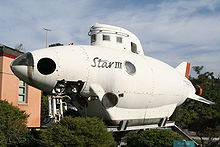
Star III, in front of Scripps Institution of Oceanography
When the Regents of the University of California originally authorized the San Diego campus in 1956, it was planned as first imagined by Roger Revelle, Director of Scripps, to start as a graduate school of science and engineering comparable in quality to Caltech. Citizens of San Diego supported the idea, voting the same year to transfer to the university 59 acres (240,000 m) of mesa land on the coast near the Scripps Institute. The Regents requested an additional gift of 550 acres (220 ha) of undeveloped mesa land northeast of Scripps, as well as 500 acres (200 ha) on the former site of Camp Matthews, but Revelle jeopardized the site selection by making public La Jolla's exclusive real estate practices antagonistic to minority racial and religious groups, angering local conservatives as well as UC Regent Edwin W. Pauley. UC President Clark Kerr satisfied San Diego city donors by changing the proposed name from University of California, La Jolla, to University of California, San Diego. The city voted in agreement to its part in 1958, and the UC approved construction of the new campus in 1960. Because of the clash with Pauley, Revelle was not made chancellor—Herbert York, first director of Lawrence Livermore National Laboratory, was designated instead. York worked out the planning of the main campus according to the "Oxbridge" model, relying on many of Revelle's ideas.
UCSD was the first general campus of the UC to be designed "from the top down" in terms of research emphasis. John Jay Hopkins of General Dynamics Corporation donated one million dollars to be used for recruiting a founding faculty. Harold Urey, Nobel winner in Chemistry, was an early recruit to the faculty in 1958. (Revelle and Suess published the first paper on the Greenhouse effect the year before.) Maria Goeppert-Mayer was appointed professor of physics in 1960; she later won the Nobel Prize in 1963. The graduate division of the school opened in 1960 with 20 faculty in residence; instruction was offered in the fields of physics, biology, chemistry and earth science. Classes initially met in the Scripps Institute.
By 1963, new facilities on the mesa been finished for the School of Science and Engineering, and new buildings were under construction for Social Sciences and Humanities. Ten additional faculty in those disciplines were hired, and the whole site was designated the First College of the new campus. York resigned as chancellor in 1963 and was replaced by John Semple Galbraith in 1964. The campus accepted its first undergraduate class of 181 freshman in 1964, and was designated Revelle College the next year. Second College was also organized in 1964, on the land deeded by the federal government. It was renamed John Muir College in April, 1966. UCSD Medical school also accepted its first students in 1966.
Political theorist Herbert Marcuse joined the faculty in 1965. A champion of the New Left, he reportedly was the first protestor to occupy the administration building in a demonstration organized by his student, Angela Davis. The American Legion offered to buy out the remainder of Marcuse's contract for $20,000; the Regents censured Chancellor McGill for defending Marcuse on the basis of academic freedom, but further action was averted after local leaders expressed support for Marcuse.
Richard C. Atkinson, chancellor from 1980-1995, strengthened UCSD's ties with the city of San Diego by encouraging technology transfer with developing companies, transforming San Diego into a world leader in technology-based industries. Private giving rose from $15 million to nearly $50 million annually, faculty expanded by nearly 50%, and enrollment doubled to about 18,000 students during his chancellorship. In 1995, the quality of UCSD's graduate programs was ranked tenth in the nation by the National Research Council.
UCSD is taking out a $40 million dollar loan against itself to offset $84.2 million in state budget cuts in 2009.
校园
Panorama of Earl Warren College mall, showing from left to right: Geisel Library, Engineering Building Unit (EBU) 1, the Powell-Focht Bioengineering Building, the Computer Science Building, and EBU 2 (visible through trees)
The university's 1,200-acre (490 ha) main campus is located near the Pacific Ocean on 1,200 acres (490 ha) of coastal woodland within the city of San Diego's "University Community" planning area. It is a lab for energy innovation.
Public art
Main article: Stuart Collection
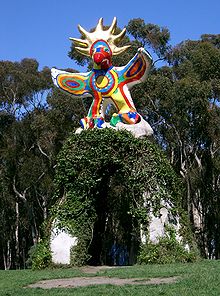
The Sun God statue by Niki de Saint Phalle
More than a dozen public art projects, part of the Stuart Collection, decorate the campus. Perhaps the most famous of these is the Sun God, a large winged creature located near the Faculty Club. Other Stuart Collection art includes a collection of Stonehenge-like stone blocks, a large coiling snake path, a building that flashes the names of vices and virtues in bright neon lights, and three metallic Eucalyptus trees, the Music Tree, the Literary Tree and the Third Tree commonly referred to as the Silent Tree. One of the newest additions to the collection is Tim Hawkinson's giant teddy bear made of six boulders located in between the newly constructed Calit2 buildings. Another notable campus sight are the graffiti tunnels of Mandeville Hall, a series of corridors that have been tagged with graffiti by generations of students over decades of use. Students in the university's visual arts department also often create temporary public art installations as part of their coursework. The university is also sponsoring a $56,000 performance art project to develop a sense of community at the sprawling campus.
In 2009, local San Diego artist Mario Torero was invited to create a mural called "Chicano Legacy" based on content suggested by UCSD Chicano students. The mural was unveiled on October 14. The mural is a $10,000 digital image on a 15-by-50-foot (4.6 by 15 m) canvas mounted on the exterior of Peterson Hall. It includes representations of Chicano civil rights leaders Cesar Chavez and Dolores Huerta as well as the signature kiosk structure at Chicano Park. It was the first mural mounted on a centrally located University-owned building to depict a minority group's history—murals on the side of cooperatively-owned Ché Café have shown minority civil rights leaders since its founding in 1980.
Organization and administration
UCSD is one of the ten general campuses of the University of California system which is governed by a publicly-appointed 26-member Board of Regents and administered by a president whose office is located in Oakland, California. Mark Yudof became the 19th president of the University system in June 2008. The board of regents appoint chancellors to serve as the chief administrative officer of each individual general campus. Marye Anne Fox became the seventh chancellor of UCSD in 2004, succeeding Robert C. Dynes who served as President of the UC system from 2003 until 2007. Chancellor Fox's total compensation was $401,091 for 2007–2008. The chancellor has an immediate staff of eight vice chancellors for academic affairs, research, marine sciences, student affairs, planning, external relations, business affairs, and health sciences.
The university operates on an academic quarter system with three primary academic quarters beginning in late September and ending in mid June.
Endowment
UCSD has at least two distinct endowments; one controlled by the Regents and another controlled by a privately-appointed non-profit corporation called the UC San Diego Foundation. In 2008, the foundation received $121.8 million in support and managed assets worth $520.7 million in total.
In 2007, UCSD became the first university in the western region to top $1 billion in their eight-year fundraising campaign.
Student government
The campus's undergraduate population is represented by a formal student government, known as the Associated Students (A.S.). Each college has its own student council as well. The campus's graduate population is represented by the Graduate Student Association (GSA). The Association's membership comprises representatives from each of the graduate departments. The number of representatives is proportional to the number of graduate students within that particular department. Additionally, graduate students who serve as teaching or research assistants are represented by the UC-wide union of Academic Student Employees, UAW Local 2865.
学术
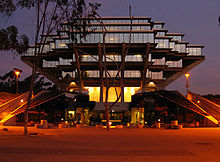
UCSD's distinctive Geisel Library, named for Theodor Seuss Geisel ("Dr. Seuss") and featured in the University's logo.
|
|
University rankings (overall)
|
|
| ARWU World |
14th |
| ARWU North & Latin America |
12th |
| Forbes |
149th |
| Times Higher Education |
58th |
| USNWR National University |
35th |
UCSD is a large, primarily residential research university. The university is accredited by the Western Association of Schools and Colleges. UCSD granted 5,337 bachelors degrees, 894 masters degrees, 488 doctorate degrees, and 125 medical degrees in 2007-2008.
UCSD's comprehensive doctoral program has high undergraduate degree coexistence as well as professional programs in business, medicine, and pharmacy. UCSD's graduate division and professional schools include the Scripps Institution of Oceanography, School of Medicine, Institute of Engineering in Medicine, Graduate School of International Relations and Pacific Studies, Jacobs School of Engineering, Rady School of Management, and Skaggs School of Pharmacy. The university offers 52 masters programs, 51 doctoral programs, 4 professional programs, and 11 joint doctoral programs with San Diego State University and other UC campuses. UCSD has noted graduate programs in biological sciences and medicine, economics, social and behavioral sciences, and physics.
Rankings
UCSD's undergraduate program ranked 7th among public universities according to the 2010 U.S. News & World Report college rankings using indicators such as endowment, giving rates, and the prior high school achievement of incoming students as metrics. The Washington Monthly ranked UCSD 2nd best overall in the nation when incorporating additional societal benefits other than just research impact as a metric, and 8th in the U.S. in terms of research alone. The Graham-Diamond report ranked UCSD 8th overall in the country. UCSD was selected as the "Hottest" science school by Newsweek in 2006. In its 2008 report on best values in public colleges, Kiplinger ranked UCSD 11th in the nation for in-state value and 17th in the nation for out-of-state value. In 2008, Times Higher Education-QS World University Rankings ranked UCSD 9th in the world in Life Sciences and Biomedicine.
Research
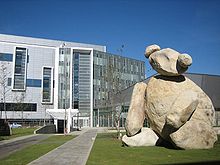
Hawkinson Bear sculpture in front of Calit2
UCSD’s total research expenditures for 2007-08 were $798 million. The National Science Foundation has ranked UCSD first in the UC system and sixth in the nation in terms of Federal research expenditures. Some 200 San Diego companies have been founded by UCSD faculty and alumni, and over 40% of the people employed in the San Diego biotechnology industry work in UCSD spin-offs. Science Watch ranked UCSD the eighth most cited institution during the period 1995 to 2005 in the field of molecular biology and genetics.
UCSD also counts among its research centers the Scripps Institution of Oceanography, the San Diego Supercomputer Center, the California Institute for Telecommunications and Information Technology, and the Center for US-Mexican Studies.
Residential colleges
UCSD's undergraduate division is organized into six residential colleges. The system is modeled off of the residential systems at Oxford and Cambridge. They each set their own general-education requirements as well as having their own administrative and advising staff and granting unique degrees and separate commencement ceremonies. In chronological order by date of foundation, the six colleges are:
- Revelle College, founded in 1964 as First College, emphasizes a "Renaissance education" and has highly structured requirements.
- John Muir College, founded in 1967 as Second College, emphasizes a "spirit of self-sufficiency and individual choice" and offers loosely structured general-education requirements.
- Thurgood Marshall College, founded in 1970 as Third College, emphasizes "scholarship, social responsibility and the belief that a liberal arts education must include an understanding of one's role in society".
- Earl Warren College, founded in 1974 as Fourth College, requires students to pursue a major of their choice while also requiring two "programs of concentration" in disciplines unrelated to each other and to their major "toward a life in balance".
- Eleanor Roosevelt College, founded in 1988 as Fifth College, which focuses its core education program on a cross-cultural interdisciplinary course sequence entitled "Making of the Modern World".
- Sixth College, founded in 2002 with a focus on "historical and philosophical connections among culture, art and technology."
Students affiliate with a college based upon its particular philosophy and environment as majors are not exclusive to specific colleges. John Muir and Earl Warren enroll the largest number of undergraduate students followed by Thurgood Marshall, Revelle, Eleanor Roosevelt, and Sixth. Each undergraduate college sets the requirements for awarding provost's honors and honors at graduation in addition to departmental honors and Phi Beta Kappa honors.
Extension
UCSD Extension is the continuing education and public program branch of the university. Approximately 50,000 enrolles per year are educated in the university's extension program. The Extension provides over 90 certificate programs and over 12 specialized study programs. Most courses are held evenings and weekends for the convenience to working adults on the main campus or at one of three off campus locations:the Extension Sorrento Mesa Center, the Extension Rancho Bernardo Center, and the Extension Mission Valley Center. The Extension program also includes online only classes. The UCSD Extension program is not affiliated with the UC Cooperative Extension program.
Charter school
The Preuss School is a charter school established on the UCSD campus in 1999 to provide an intensive college preparatory curriculum for low-income students from the greater San Diego area. The Preuss school has been ranked as one of the top ten best high schools in the United States by US News & World Report.
Admissions and enrollment
Ethnic enrollment, Fall 2009
| Ethnicity |
Undergraduate |
| African American |
2% |
| Asian American |
48% |
| Hispanic American |
13% |
| Native American |
0% |
| European American |
26% |
| Unreported/unknown |
10% |
UCSD received 47,069 freshmen applicants for the Fall 2009, and admitted 37.3%. Also, the number of students applying to UCSD makes it the third most popular UC campus, after UCLA and UC Berkeley. Admitted students attained a mean weighted high school GPA of 4.08 and average SAT scores of 637, 677, and 650 for Critical Reading, Math and Writing, respectively. The average ACT Composite Score is 29. Of the 17,000 freshmen that were admitted, 99% were in the top 10% of their high school class. 31% of admitted students receive federal Pell Grants. The top four overlapping schools for applicants are: UC Berkeley, UCLA, USC, and Stanford University.
The four year, full-time undergraduate program comprises the majority of enrollments at the university. The university offers 125 bachelors degree programs organized into six disciplinary divisions: Arts, Humanities, Engineering, Science/Math, Biological Sciences, and Social Sciences. 37% of undergraduates major in the social sciences, followed by 24% in biological sciences, 17% in engineering, 8% in sciences and math, 4% in humanities, and 4% in the arts. Each undergraduate colleges sets its own general education requirements (GEs) for graduation in addition to the specific requirements of majors set by individual departments and programs.
Graduate admissions are largely centralized through the Office of Graduate Studies. However, the Rady School of Management, Scripps Institution of Oceanography, and the Graduate School of International Relations and Pacific Studies (IR/PS) handle their own admissions.
In 2009, UCSD mistakenly sent Admit Day welcome emails to all its 47,000 freshmen applicants, instead of just the 17,000 who had been admitted. However, school officials quickly realized the mistake and sent an apology email within two hours.
Student life
The main student hub is the Price Center located in the center of campus, just south of Geisel Library. The Price Center offers a variety of services, places, and spaces, including restaurants, the central bookstore, movie theater, and various student organizations. In the Spring of 2003, a Student Referendum was passed to expand the Price Center to nearly double the original size. The Price Center East expansion was officially opened to the public on May 19, 2008.
There are also three campus centers that cultivate a sense of community among faculty, staff, and students: the Cross-Cultural Center, the Women's Center, and the LGBT Resource Center. UCSD was the last UC campus to have such centers. All three centers, especially the Cross-Cultural Center that was created first, were founded in the mid-1990s and were the result of student movements that demanded change despite opposition by the campus administration.
There is a music venue on the campus grounds of some fame called the Ché Café, a collective organization serving multiple functions as an underground music venue, vegan food collective, center for grassroots organizations such as Food Not Bombs, and similar groups and activities. Prominent local San Diego bands such as The Locust and Pinback, and national tours such as Mates of State and The Dillinger Escape Plan have given the Ché Café some fame and praise as a radical vegan collective despite its small size (it fits a few hundred people) and limited sound equipment.
International Housing
International House is home to about 240 students from more than thirty countries. The I-House community provides a social atmosphere where opportunities for significant cross-cultural exchange between American and international students is plentiful. International learning is fostered through formal programs including current affairs discussions, cultural nights, and a community newsletter. Upper-division undergraduates from all six colleges, graduate students, faculty, and researchers are eligible to live in International House, located in the Eleanor Roosevelt College townhouses. Demand is very high for this special program and there is a waitlist each quarter. Spaces in International House are not guaranteed and admission requires a separate application.
Events and traditions
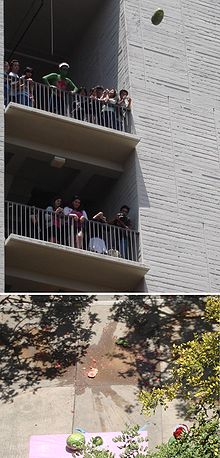
The June 2007 Watermelon Drop, an annual tradition at Revelle College
The Associated Students also coordinates a wide variety of concerts and events during the year, including All Campus Dance, Bear Gardens, Loft Events, and the Sun God Festival. The Sun God Festival, named after the statue created by artist Niki de Saint Phalle, is the best-known of the festivals. During the event, there are day long series of concerts, performances, free items, and celebration before the final free concert takes place in the evening.
Two other popular campus events include the Pumpkin Drop and the Watermelon Drop, which take place during Halloween and at the end of the third (Spring) academic quarter, respectively. The Watermelon Drop is one of the campus's oldest traditions, famously originating in 1965 from a physics exam question centering on the velocity on impact of a dropped object. A group of intrigued students pursued that line of thought by dropping a watermelon from the top floor of Revelle's Urey Hall to measure the size of the resulting splat. A variety of events surround the Watermelon Drop, including a pageant where an occasionally male but generally female "Watermelon Queen" is elected. In 1979 the Queen rode to Urey Hall in a theatrical-prop sedan chair that had been knocking around the Revelle dorms for years. The Pumpkin Drop is a similar event celebrated by the dropping of a large, candy-filled pumpkin from 11-story Tioga Hall, the tallest residential building on the Muir college campus.
Student media
See also: UCSD TV
|
|
The neutrality of this section is disputed. Please see the discussion on the talk page. Please do not remove this message until the dispute is resolved. (February 2010) |
The campus newspaper, operated independent of student funds, is the UCSD Guardian. The campus also hosts a small independent radio station, KSDT, which no longer broadcasts over the airwaves, but still operates online. UCSD-TV transmitted its first moments on air in 1993. Over the last 15 years it has spread to over 1 million televisions sets and produces 150 programs a year. The station focuses on diverse and intellectual subject matter. UCSD-TV's "Health Matters" production has been honored with an Emmy Award, and the station as a whole has received various Telly Awards.
One of the more controversial aspects of student life at UCSD is the student-run comedy paper, The Koala, a satirical paper often criticized for its provocative articles and drawings, which is also funded by the A.S. In 2005, the student council made national news over a controversy regarding pornography broadcast over the A.S.-funded television station by members of The Koala.
In February 2010, members of The Koala, on their Student Run Television program "Koala TV" publicly supported the "Compton Cookout", a controversial off-campus party mocking Black History Month that included UCSD fraternity members among the organizers.
体育运动
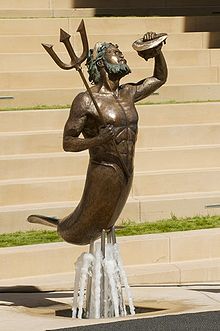
Athletic mascot, the Triton
Main article: UCSD Tritons
UCSD offers student participation in a wide range of sports including swimming, water polo, soccer, volleyball, crew, track and field athletics, fencing, basketball, golf, cross country, softball, baseball, and tennis. UCSD participates at the NCAA's Division II (DII) level in the California Collegiate Athletic Association, although water polo, fencing, and men's volleyball compete at the Division I level. Before joining DII in 2000, the school participated at the Division III level and won numerous national championships.
UCSD does not have an NCAA football team.
Until the 2007-2008 school year, UCSD was the only DII school that did not offer athletic scholarships. In 2005, the NCAA created a rule that made it mandatory for DII programs to award athletic grants; a measure was proposed to begin offering $500 "grants-in-aid" to all 600 intercollegiate athletes in order to meet this requirement. In February 2007, a student referendum was passed with the largest vote in UCSD history, authorizing a $329 annual student fee to fund a raise in coaches' salaries, hire more trainers and provide all athletes with a $500 scholarship.
In 2006-2007, UCSD's best season since moving to DII, 19 of 23 athletic programs qualified for post-season competition, including 17 to the NCAA Championships. Eight of those teams finished in the top-5 in the nation.
UCSD fields a number of club sports teams. The UCSD surfing team has won the national title six times and is consistently rated one of the best surfing programs in the nation. The UCSD triathlon team is continually one of the top triathlon teams in the nation. In 2008, the women's triathlon team won the US collegiate national championship and UCSD athlete Amanda Felder was the Overall Nation Champion. UCSD also has sport clubs in badminton, cycling, dancesport, dance team, equestrian, ice hockey, lacrosse, roller hockey, rugby union, sailing, soccer, snow skiing, table tennis, ultimate, volleyball, water polo, and waterskiing.
The National Collegiate Scouting Association (NCSA) 2008 Collegiate Power Rankings rate colleges and universities comprehensively based on student-athlete graduation rates, academic strength and athletic prowess of the university. The institutions posted in the 2007 Power Rankings represent less than 6% of colleges and universities across the nation. UCSD placed 4th on the overall ranking list, trailing behind Williams College, Amherst College, and Duke University, and first on the Division II list.
[edit] People
Main article: List of University of California, San Diego people
Faculty
The university employs 7,566 faculty members, including eight Nobel Laureates, eight MacArthur fellows, three National Medal of Science laureates, and one Fields medalist. Sixteen UCSD faculty members have won the Nobel Prize, nine of whom are currently on the faculty. UCSD faculty also include nine MacArthur Fellows and 146 Guggenheim Fellows. UCSD ranks sixth in the nation in terms of United States National Academy of Sciences membership. UCSD has a total of 18 Nobel Laureates affiliated with it.
Alumni
See also: UCSD Alumni Association
Over 130,000 alumni are associated with UCSD. Notable alumni include Bill Atkinson and Bud Tribble, members of the Apple Macintosh development team; biotechnology pioneers David Goeddel and Craig Venter, and Nobel Prize winner Susumu Tonegawa, recognized for his work in immunology. Eleanor Mariano, the first Filipino-American to reach the rank of Rear Admiral in the United States Navy and first female director of the White House Medical Unit, received her BS in Biology cum laude in 1977. A number of science fiction authors including Gregory Benford, David Brin and Kim Stanley Robinson earned PhDs at UCSD; cartoon animation producer Mike Judge is also an alum.
参考文献
- ^ UC Annual Endowment Report Office of the Treasurer of The Regents Retrieved March 31, 2010
- ^ "University of California Full-Time and Part-Time Headcount - SMG & MSP, Academic and PSS Personnel" (PDF). Statistical Summary of Staff and Students. University of California Office of the President. April 2009. http://www.ucop.edu/ucophome/uwnews/stat/headcount_fte/apr2009/er1sdh.pdf. Retrieved 2009-07-17.
- ^ "Result vote for ASUCSD Election Election" (PDF). Associated Students of UCSD. 2009-01-16. http://as.ucsd.edu/elections/AS09SP_Elections.pdf. Retrieved 2009-07-17.
- ^ "Fall 2008: University of California Statistical Summary of Students and Staff" (PDF). University of California Office of the President - Department of Information Resources and Communications. 2009-04-02. http://www.ucop.edu/ucophome/uwnews/stat/statsum/fall2008/statsumm2008.pdf. Retrieved 2009-07-17.
- ^ Getting to Know San Diego
- ^ "San Diego: Historical Overview". University of California History Digital Archives. http://sunsite.berkeley.edu/~ucalhist/general_history/campuses/ucsd/overview.html. Retrieved 2008-09-17.
- ^ "Degrees Awarded" (PDF). University of California, San Diego. http://ir.ucsd.edu/Files/Degrees/1961-Present.pdf. Retrieved 2008-09-17.
- ^ "University of California, San Diego Triton Stats" (PDF). University of California, San Diego. http://ir.ucsd.edu/Files/Fastfacts/0708%20ucsd%20fast%20facts.pdf. Retrieved 2008-09-17.
- ^ http://colleges.usnews.rankingsandreviews.com/best-colleges/los-angeles-ca/ucla-1315
- ^ "Washington Monthly: 2009 National University Rankings". Washington Monthly. 2009. http://www.washingtonmonthly.com/college_guide/rankings/national_university_rank.php. Retrieved 2009-10-08.
- ^ "Institutions: University of California-San Diego". The Carnegie Foundation for the Advancement of Teaching. http://www.carnegiefoundation.org/classifications/sub.asp?key=748&subkey=13415&start=782. Retrieved 2008-09-17.
- ^ "Association of American Universities: Member Institutions and Years of Admission. Retrieved on 2009-07-16". http://www.aau.edu/about/article.aspx?id=5476.
- ^ Kerr, Clark (2003), The Gold and the Blue: A Personal Memoir of the University of California, 1949-1967 Volume I: Academic Triumphs, Berkeley: University of California Press, pp. 248, 254–260, http://books.google.com/books?id=jMEZ_47vXkAC&pg=RA1-PA254, retrieved 2009-07-20
- ^ Stadtman, Verne A. "The University of California, 1868-1968," pages 407-411
- ^ Gribble, Joanne (2000-09). "Forty Years of UCSD Perspective". San Diego Metropolitan. Archived from the original on 2008-04-17. http://web.archive.org/web/20080417234035/http://www.sandiegometro.com/2000/sep/coverstory.html. Retrieved 2009-07-20.
- ^ Stadtman, Verne A. (1967), The Centennial Record of the University of California, Office of the Regents of the University of California, Office of the Secretary, http://content.cdlib.org/xtf/view?docId=hb4v19n9zb&doc.view=frames&chunk.id=div00852&toc.depth=1&toc.id=div00852&brand=calisphere, retrieved 2007-08-10
- ^ University of California History Digital Archives
- ^ Barberella (2007-08-23). "The Bourgeois Marxist". San Diego Reader. http://www.sandiegoreader.com/news/2007/aug/23/bourgeois-marxist/. Retrieved 2009-07-20.
- ^ Smilor, Raymond; Niall O'Donnell, Gregory Stein, Robert S. Welborn (2007-08-01). "The Research University and the Development of High-Technology Centers in the United States". Economic Development Quarterly 21 (3): 203–222. doi:10.1177/0891242407299426. http://edq.sagepub.com/cgi/content/abstract/21/3/203. Retrieved 2009-07-17.
- ^ Yang Su, Eleanor (2009-10-07). "To soften cuts, UCSD to borrow from itself, $40 million internal loan announced by campus". San Diego Union-Tribune. http://www3.signonsandiego.com/stories/2009/oct/07/soften-cuts-ucsd-borrow-itself/?education&zIndex=178537. Retrieved 2009-09-20.
- ^ "San Diego Community Profile: University". City of San Diego. http://www.sandiego.gov/planning/community/profiles/university/index.shtml. Retrieved 2009-07-21.
- ^ "About UCSD". Official Web site of the University of California, San Diego. Regents of the University of California. 2009-07-16. http://www.ucsd.edu/explore/about/index.html. Retrieved 2009-07-17.
- ^ Soto, Onell R. (2009-09-20). "UCSD becoming lab for energy innovation - SignOnSanDiego.com". San Diego Union-Tribune. http://www3.signonsandiego.com/stories/2009/sep/20/ucsd-becoming-lab-energy-innovation/?education&zIndex=169045. Retrieved 2009-09-20.
- ^ Markhoff, John (November 5, 2005), "Researchers Look to Create a Synthesis of Art and Science for the 21st century -", The New York Times, http://www.nytimes.com/2005/11/05/arts/05lab.html, retrieved 2008-02-03
- ^ Steinberg, Janice (February 18, 2007), "'Place': Building a community at UCSD", The San Diego Union-Tribune, http://www.signonsandiego.com/uniontrib/20070218/news_1a18place.html, retrieved 2008-02-07
- ^ Clark, Christine (October 19, 2009). "Students Welcomed to Campus by New Mural Celebrating Chicano History". This Week @ UCSD. http://ucsdnews.ucsd.edu/thisweek/2009/10/19_mural.asp. Retrieved 2010-01-01.
- ^ Berestein, Leslie (October 13, 2009). "A celebration of culture: Chicano history mural to be officially unveiled UCSD campus". The San Diego Union-Tribune. http://www3.signonsandiego.com/stories/2009/oct/13/celebration-culture/. Retrieved 2010-01-01.
- ^ "Governance at UC". University of California. http://www.universityofcalifornia.edu/aboutuc/governance.html. Retrieved 2009-07-18.
- ^ "Governance at UC". University of California. http://www-chancellor.ucsd.edu/biography.html. Retrieved 2009-07-18.
- ^ "Presidents' Pay and Benefits at Public Institutions". Chronicle of Higher Education. http://chronicle.com/premium/stats/990/public.php?keyword=marye+anne+fox&radio=Prez&Year=2008&State=&type=. Retrieved 2009-07-19.
- ^ "UCSD Administrative Organization Chart". University of California, San Diego. http://adminrecords.ucsd.edu/PPM/docs/10-0.pdf. Retrieved 2009-07-18.
- ^ Catalog 2010, p. 5
- ^ "About UC San Diego Foundation". UC San Diego Foundation. http://ucsdfoundation.ucsd.edu/about_us.asp. Retrieved 2009-07-18.
- ^ "2008 Financial Statement". UC San Diego Foundation. http://www-er.ucsd.edu/foundationDir/pdf/UCSDFoundation2007-2008.pdf. Retrieved 2009-07-18.
- ^ "UC San Diego Becomes Region’s First University to Top $1 Billion in a Fundraising Campaign". Ucsdnews.ucsd.edu. http://ucsdnews.ucsd.edu/newsrel/general/06-081BillionFundraisingLM-.asp. Retrieved 2009-07-16.
- ^ "Associated Students of UCSD". As.ucsd.edu. 2009-06-08. http://as.ucsd.edu. Retrieved 2009-07-16.
- ^ "FAQ's about UCSD's Six Colleges". Official Web site of the University of California, San Diego. Regents of the University of California. 2009-07-15. http://www.ucsd.edu/prospective-students/undergraduate-college-system/faqs.html#select. Retrieved 2009-07-17.
- ^ "UCSD Graduate Student Association". Gsa.ucsd.edu. http://gsa.ucsd.edu. Retrieved 2009-07-16.
- ^ UCSD Libraries Fact Sheet - UCSD Libraries
- ^ Shanghai Jiao Tong University (2009). "Academic Ranking of World Universities". Institute of Higher Education, Shanghai Jiao Tong University. http://www.arwu.org/ARWU2009.jsp. Retrieved 2009-12-23.
- ^ Shanghai Jiao Tong University (2009). "Ranking of North & Latin American Universities". Institute of Higher Education, Shanghai Jiao Tong University. http://www.arwu.org/Americas2009.jsp. Retrieved 2009-12-23.
- ^ "America's Best Colleges". Forbes. 2009. http://www.forbes.com/lists/2009/94/colleges-09_Americas-Best-Colleges_Rank.html. Retrieved 2009-09-13.
- ^ The Times (2009). "World University Rankings". The Times Higher Educational Supplement. http://www.topuniversities.com/university-rankings/world-university-rankings/2009/results. Retrieved 2010-02-09.
- ^ "National Universities Rankings". America's Best Colleges 2009. U.S. News & World Report. 2009. http://colleges.usnews.rankingsandreviews.com/college/national-search. Retrieved 2009-05-18.
- ^ Catalog 2010, p. 8
- ^ "Accreditation". University of California, San Diego. http://accreditation.ucsd.edu/. Retrieved 2009-07-18.
- ^ "Degrees Conferred: All Degree Types". Student Research and Information, Student Affairs. http://studentresearch.ucsd.edu/sriweb/degrees/degsumm.pdf. Retrieved 2009-07-18.
- ^ "Academic Ranking of World Universities in Clinical Medicine and Pharmacy - 2009". Shanghai, China: Center for World-Class Universities and the Institute of Higher Education of Shanghai Jiao Tong University. 2009. http://www.arwu.org/ARWUFIELD2009MED.jsp. Retrieved 2009-11-22.
- ^ "Best Medical Schools: Primary Care Rankings". America's Best Graduate Schools. U.S. News & World Report. 2009. http://grad-schools.usnews.rankingsandreviews.com/best-graduate-schools/top-medical-schools/primary-care-rankings. Retrieved 2009-05-18.
- ^ Diamond, Nancy; Hugh Davis Graham (2008-06). "How Should We Rate Research Universities". Northwestern University. Archived from the original on 2007-04-16. http://web.archive.org/web/20070416075915/http://www.physics.northwestern.edu/graduate/Graham_Diamond.html. Retrieved 2008-03-24.
- ^ "Best Colleges: Top Public Schools: National Universities". U.S. News & World Report. http://colleges.usnews.rankingsandreviews.com/best-colleges/national-top-public. Retrieved 2010-03-24.
- ^ "National University Rankings". The Washington Monthly. http://www.washingtonmonthly.com/college_guide/rankings/national_university_rank.php. Retrieved 2010-03-27.
- ^ Matthews, Jay (2005-08-22). "America's Hot Colleges". Newsweek. http://www.newsweek.com/id/56504/page/1. Retrieved 2008-03-11.
- ^ "100 Best Values in Public Colleges". Kiplinger.com. 2008. http://www.kiplinger.com/tools/colleges/. Retrieved 2008-03-11.
- ^ "Times Higher Education-QS World University Rankings 2009 - Life sciences and Biomedicine". http://www.timeshighereducation.co.uk/.+2009. http://www.timeshighereducation.co.uk/hybrid.asp?typeCode=423. Retrieved 2010-02-18.
- ^ "Uc San Diego News Center : About Uc San Diego". Ucsdnews.ucsd.edu. 2009-06-08. http://ucsdnews.ucsd.edu/about/index.html#impact. Retrieved 2009-07-16.
- ^ "Medical Scientist Training Program ~ Ucsd General Campus". Meded.ucsd.edu. http://meded.ucsd.edu/asa/mstp/research_opportunities/ucsd_general_campus/. Retrieved 2009-07-16.
- ^ "University of California, San Diego Profile" (PDF). University of California Office of the President. 2005-02-25. http://www.ucop.edu/news/profiles/ucsd.pdf. Retrieved 2007-07-17.
- ^ Markoff, John (1997-03-24). "An Information Revolution Revives Its Economy". New York Times. http://query.nytimes.com/gst/fullpage.html?res=990DE4D7133BF937A15750C0A961958260. Retrieved 2008-08-03.
- ^ "The Most-Cited Institutions in Molecular Biology & Genetics, 1995-2005". The Thomson Corporation. 2006-03. http://www.in-cites.com/institutions/mol_1995-2005.html. Retrieved 2008-03-26.
- ^ Catalog 2010, p. 9
- ^ "Commencement". Ucsd.edu. http://www.ucsd.edu/current-students/academics/commencement/. Retrieved 2009-07-16.
- ^ Catalog 2010, p. 12
- ^ "Undergraduates by College". Student Research and Information, Student Affairs. http://studentresearch.ucsd.edu/sriweb/enroll/ugcoll.pdf. Retrieved 2009-07-18.
- ^ "UC San Diego Extension - Catalog Fall 2009" (PDF). UC San Diego, Extension. 2009-08. http://extension.ucsd.edu/pdf/student/catalog/front.pdf. Retrieved 2009-07-17.
- ^ "UC Delivers". University of California. http://ucanr.org/delivers/categories.cfm. Retrieved 2010=03-09.
- ^ "About The Preuss School UCSD". Preuss.ucsd.edu. http://preuss.ucsd.edu/about/. Retrieved 2009-07-16.
- ^ "Best High Schools: Top Charter Schools". US News & World Report. 2007-11-29. http://www.usnews.com/articles/education/high-schools/2007/11/29/top-charter-schools.html. Retrieved 2008-03-24.
- ^ "Undergraduates by ethnicity". Total Undergraduate Enrollment Statistics. Student Research & Information, University of California, San Diego. http://studentresearch.ucsd.edu/sriweb/enroll/ugethnic.pdf. Retrieved 2009-07-22.
- ^ "Introducing the University" (PDF). Student Affairs, Office of the President, University of California. 2009-04. http://www.universityofcalifornia.edu/admissions/ITU.pdf. Retrieved 2009-07-17.
- ^ "University of California - Admissions". Universityofcalifornia.edu. http://www.universityofcalifornia.edu/admissions/undergrad_adm/selecting/camp_profiles/camp_profiles_ucsd.html. Retrieved 2009-07-16.
- ^ "Introducing the university" (PDF). http://www.universityofcalifornia.edu/admissions/ITU.pdf.
- ^ "Economic Diversity Among All National Universities", U.S. News & World Report, archived from the original on 2008-01-01, http://web.archive.org/web/20080101134424/http://colleges.usnews.rankingsandreviews.com/usnews/edu/college/rankings/brief/natudoc_ecodiv_brief.php, retrieved 2007-08-10
- ^ "University of California, San Diego Trtiton States 2007-2008". Institutional Research, University of California, San Diego. http://ir.ucsd.edu/Files/Fastfacts/0708%20ucsd%20fast%20facts.pdf. Retrieved 2009-07-18.
- ^ "Undergraduate Enrollment by Major Field of Study". Student Research and Information, Student Affairs. http://studentresearch.ucsd.edu/sriweb/enroll/ugdisc.pdf. Retrieved 2009-07-18.
- ^ Catalog 2010, pp. 16-31
- ^ Catalog 2010, p. 55
- ^ NBC San Diego News. Oops! UCSD Sends Acceptance E-mail to Wrong List
- ^ Holland, Gale (2009-04-01). "UC San Diego admissions gaffe dashes students' hopes - again - Los Angeles Times". Latimes.com. http://www.latimes.com/news/local/la-me-ucsd-reject1-2009apr01,0,7943711.story. Retrieved 2009-07-16.
- ^ "The Guardian - Campus E-Mail Mistakenly Welcomes All Applicants". Ucsdguardian.org. 2009-04-02. http://www.ucsdguardian.org/news/campus-e-mail-mistakenly-welcomes-all-applicants-1.1640689. Retrieved 2009-07-16.
- ^ "Campus Celebrates Opening of Price Center Expansion with Launch Party". Ucsdnews.ucsd.edu. 2008-05-19. http://ucsdnews.ucsd.edu/thisweek/2008/05/19_pce-launch.asp. Retrieved 2009-07-16.
- ^ "UCSD :: Cross-Cultural Center". Ccc.ucsd.edu. http://ccc.ucsd.edu/About.asp. Retrieved 2009-07-16.
- ^ Ché Café Collective
- ^ UC San Diego Housing - The Six Colleges and La Jolla Living
- ^ "Concerts + Events :: Associated Students :: About". Concerts.ucsd.edu. http://concerts.ucsd.edu/pages/about. Retrieved 2009-07-16.
- ^ "College Traditions". Ucsd.edu. http://www.ucsd.edu/prospective-students/undergraduate-college-system/college-traditions.html. Retrieved 2009-07-16.
- ^ "Press Release - UCSD-TV - University of California Television - San Diego". Ucsd-Tv. http://www.ucsd.tv/articles/2008-0327.shtml. Retrieved 2009-07-16.
- ^ "About UCSD-TV - University of California Television - San Diego". Ucsd.tv. http://www.ucsd.tv/about.shtml. Retrieved 2009-07-16.
- ^ "Press Releases". Ucsd-Tv. http://www.ucsd.tv/press/. Retrieved 2009-07-16.
- ^ FIRE - Student Humor Magazine Prosecuted for Parody at UCSD: University Decision Expected This Week
- ^ Gordon, Larry (February 18, 2010). "UC San Diego condemns student party mocking Black History Month". Los Angeles Times. http://www.latimes.com/news/local/la-me-ucsd18-2010feb18,0,5698009.story. Retrieved March 29, 2010.
- ^ Drooz, Alan (2002-11-04), "Giving it the old college Triton", The San Diego Union-Tribune, http://www.signonsandiego.com/sports/drooz/20021028drooz.html, retrieved 2008-02-25
- ^ Yang Su, Elinor (2007-02-03). "Athletic fee hike approved at UCSD". The San Diego Union-Tribune. http://www.signonsandiego.com/uniontrib/20070203/news_7m3ucsd.html. Retrieved 2009-07-22.
- ^ "Earl Edwards Named the NACDA Division II West Region Athletic Director of the Year - UCSDTritons.com—Official Web Site of UC San Diego Athletics". Ucsdtritons.com. 2005-09-02. http://www.ucsdtritons.com/ViewArticle.dbml?DB_OEM_ID=5800&ATCLID=921992. Retrieved 2009-07-16.
- ^ Clark, Christine (2008-11-19). "UC San Diego a Top Surfing School". Ucsdnews.ucsd.edu. http://ucsdnews.ucsd.edu/newsrel/general/11-08UCSDTopSurfing.asp. Retrieved 2009-07-16.
- ^ "UC San Diego Recreation - Sports Clubs :: Triathlon". Recadmin.ucsd.edu. 2007-11-21. http://recadmin.ucsd.edu/sports/teams/triathlon/overview.php. Retrieved 2009-07-16.
- ^ "Sports Clubs". UC San Diego Recreation. Regents of the University of California. http://recadmin.ucsd.edu/sports/. Retrieved 2009-07-17.
- ^ "NCSA Collegiate Power Rankings". National Collegiate Scouting Association. http://www.ncsasports.org/recruiting-tools/baseball/power-rankings/%28year%29/2008/%28tab%29/0. Retrieved 2009-07-21.
- ^ "National Collegiate Scouting Association Announces 2007 Collegiate Power Rankings". National Collegiate Scouting Association. 2007-08-20. http://www.prnewswire.com/cgi-bin/stories.pl?ACCT=104&STORY=/www/story/08-20-2007/0004648309&EDATE=. Retrieved 2008-03-11.
- ^ "UCSD Alumni Association: Board of Directors". Alumni.ucsd.edu. http://alumni.ucsd.edu/aboutus/board.htm. Retrieved 2009-07-16.
- ^ "Prominent Alumni". UCSD Alumni Association. University of California, San Diego. http://alumni.ucsd.edu/prominent/index.htm. Retrieved 2009-07-30.
External links
 |
Wikimedia Commons has media related to: UCSD |
- Official website
- Historical Overview of UCSD



